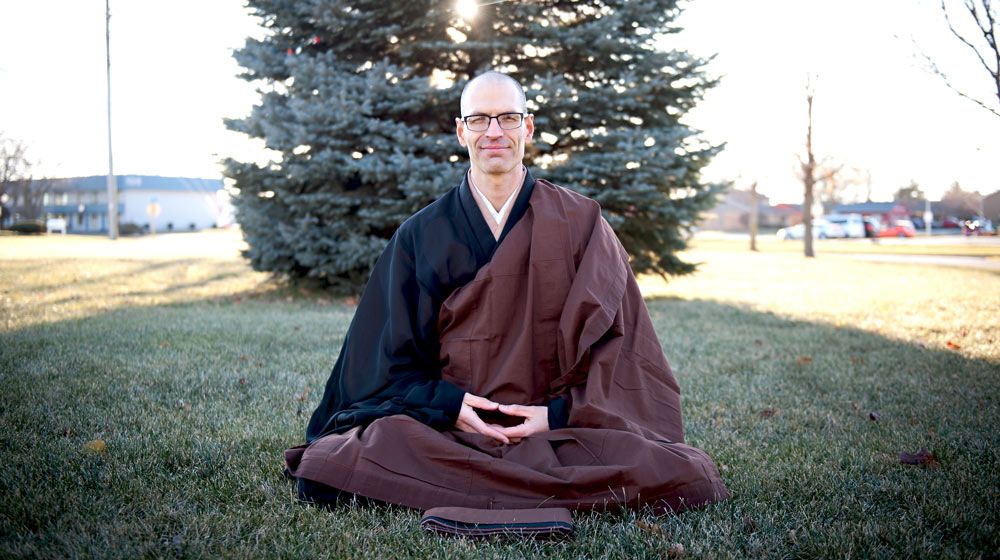Buddhist monk and yoga teacher Daishin Eric McCabe found strength is stillness

In the early 1990s, Eric McCabe was studying religion in his college classroom; on the side, he was experiencing a spiritual crisis.
He was raised Catholic, and his classes at Bucknell University were starting to make him doubt the existence of God for the first time in his life.
“It started to call up questions for me of what my purpose was. What should I do while I’m here? How should I do it?” McCabe said. “Around the same time is when I met my teacher.”
McCabe’s introduction to Buddhism was through Mt. Equity Zendo, a meditation center near his campus in Lewisburg, Pennsylvania. His teacher was Rev. Patricia Dai-En Bennage, a Soto Zen nun and former ballerina.
“Everything that she said I felt was in alignment with her body,” he said. “She just had a real beauty with the way she was able to keep stillness in her own body.”
This stillness is essential to Soto Zen, the largest of the three traditional Japanese sects of Buddhism. Zazen, or seated meditation, is designed to root the practitioner in the present, allowing her or him to take in the true reality of the world — unclouded by human fears, ego and attachments. Observance of precepts, the chanting of sutras (such as the lotus and heart sutras) and appreciation for the lineage of teachers, all the way back to the Buddha himself, are part of the Soto Zen path to contentment.
“I think we go on a journey because we think there’s something wrong with us, but Buddhism affirms that who we are right now is 100 percent perfect.”
“I was also attracted to the fact Buddhism doesn’t say anything about believing in God or not believing in God,” McCabe said. “The main concern is the acknowledgment of suffering and that there is an end to suffering. I thought, wow, this is really very, very practical.”
Bennage prescribed McCabe a book, and just the title made him question the college mindset: young people preoccupied with the future while neglecting their present, often with the use of alcohol and drugs. The book was Being Nobody, Going Nowhere by Ayya Khema.
“There’s something about that turn of words that really centered me,” McCabe said. “It wasn’t that I should give up on trying to be somebody, but there was another half I had been missing, and that was it.”
“I think we go on a journey because we think there’s something wrong with us, but Buddhism affirms that who we are right now is 100 percent perfect,” he explained. “There is a journey into the present moment.”
McCabe found yoga in the late-’90s, around the same time millions of other Americans did, although his yoga training was more spiritual than most. He trained with Integral Yoga’s Yogaville, where yoga’s ancient history, including its ties to Hinduism and Buddhism, were observed. He would go on to become a certified Hatha yoga teacher and completed a 15-year apprenticeship with Bennage that took him to Japan, France, California and Nebraska. He also finished his religion and biology bachelor’s degree programs at Bucknell.
Meditation served his mind and spirit, but yoga was a way to engage his body. McCabe had been a competitive swimmer from the ages of 7 through 21, and he knew how important the connection between mind and body was in keeping both pliable and healthy.
McCabe currently teaches zen meditation, Japanese calligraphy, yoga and mindfulness in the Des Moines area. He has taught at drug and alcohol rehab centers and Fort Dodge Prison, and leads Trauma Sensitive Yoga at Broadlawns Medical Center in Des Moines. It’s not always appropriate to infuse his yoga classes with Buddhist teachings, he said, but that doesn’t mean they’re not spiritual.
“You can be doing physical exercises in a gym and be totally unaware of your body. What makes yoga different from just a physical practice, if it’s really yoga, is that you’re bringing mindfulness into our body,” he said. “To me, that’s spiritual, whether we call it that or not … Right now it feels yoga is kind of a conduit for expressing [one’s faith], no matter what religious context you’re in.”
McCabe lives in Ames with his wife and 10-month-old son. It can be hard for new parents to find a spare moment for a Sun Salutation, let alone silent meditation, but McCabe hasn’t had trouble. Everything from teaching a class to driving a car to changing a diaper can be spiritual, with the right sense of awareness.
“To me, Buddhism isn’t just a philosophy or an idea, it’s something we embody. It’s the way we walk, it’s found in the rituals we do … There’s no separation between our daily life and meditation or yoga,” he said. “When I’m awake, I’m interacting with the world at every opportunity. To me, that’s where yoga practice is.”
Emma McClatchey is the managing editor of YogaIowa. She can be reached at emma@littlevillagemag.com. This article was originally published in YogaIowa’s Winter 2018 issue.


